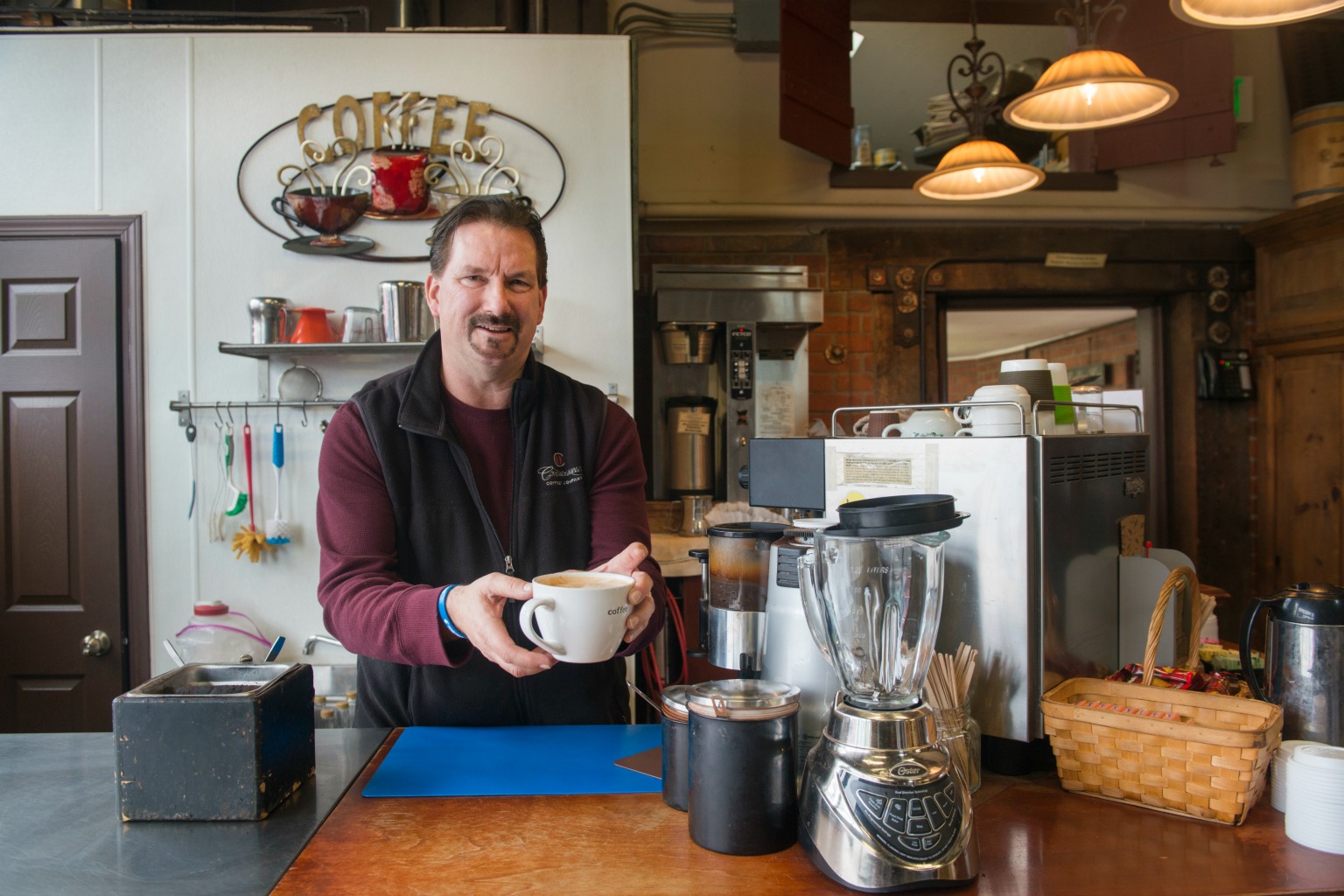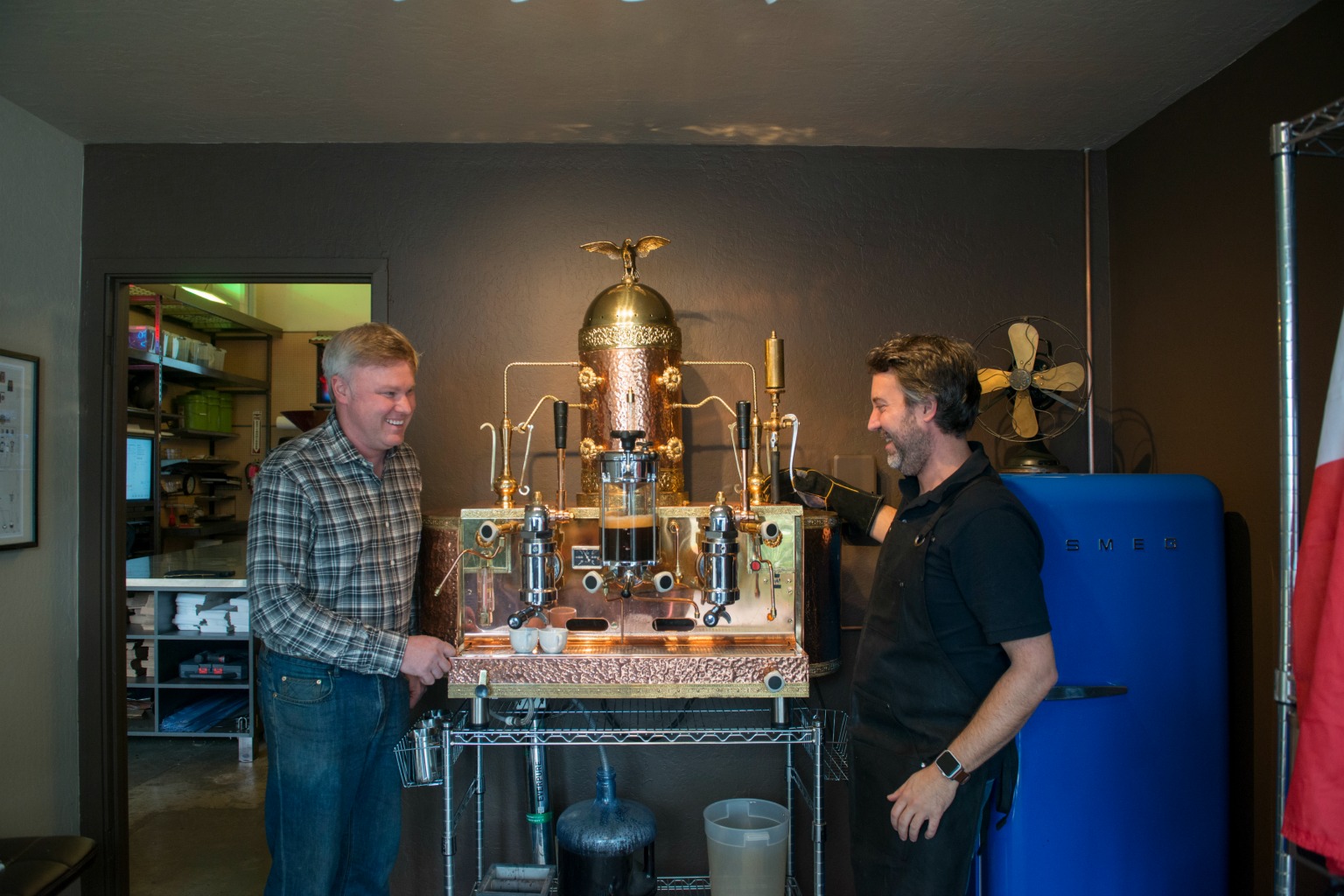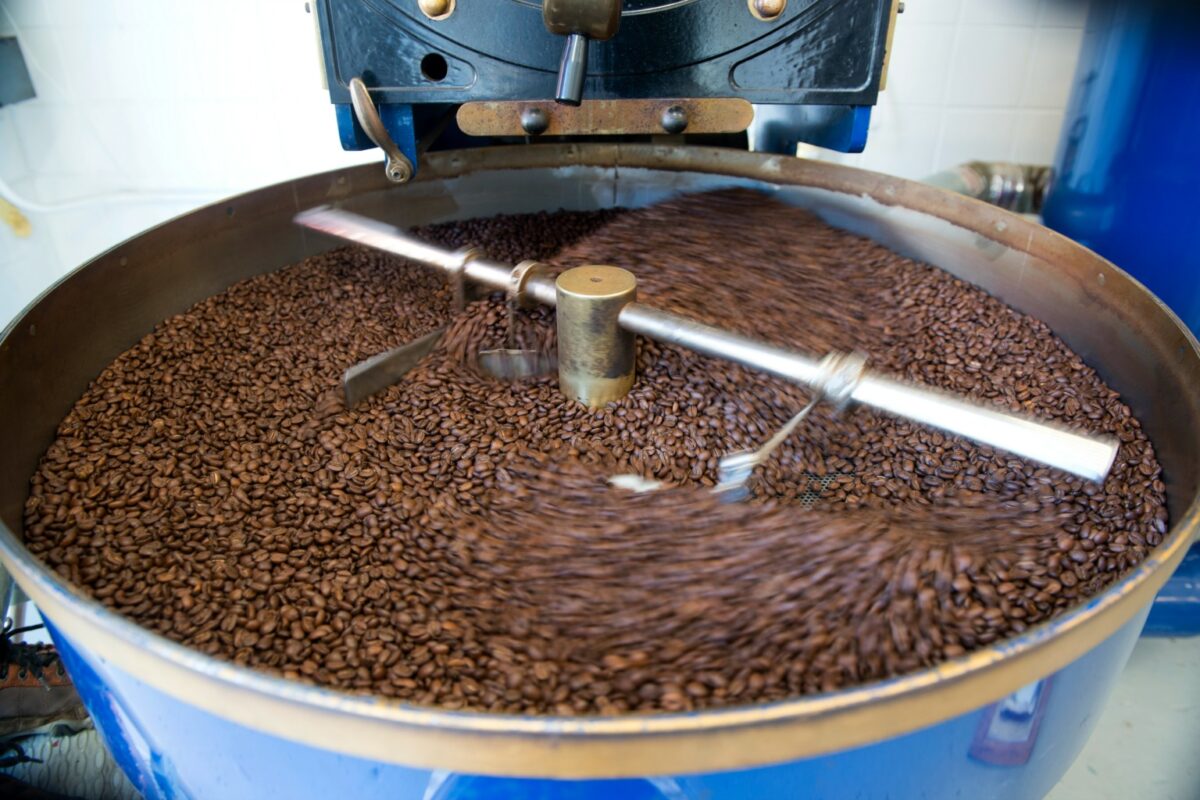Words by Sheri Baer
In the constant debate over what fuels innovation in Silicon Valley, caffeine is certainly a contender, evidenced by the countless coffee shops, stops and stations scattered all over the Peninsula. With gas increasingly being replaced by electric volts, “Fill ‘er up!” is just as likely to mean a thermos or mug these days, with octane levels defined by light, medium and dark roasts and single, double and triple shots. But before the first sip, or even that first drip, comes the bean. To better understand what drives our local
coffee culture, we got the scoop from three very different flavors of Peninsula coffee roasters.

AHEAD OF THE TREND
Connoisseur Coffee Company is situated in a tucked-in-plain-sight storefront on Middlefield Road in Redwood City, an artisanal shop “with a passion to roast coffee and do it the right way.” This self-described “industrial chic” roastery is actually one of the oldest on the Peninsula, originally founded in 1980 in downtown Palo Alto before settling in on Middlefield Road in 1984. “We were roasting coffee before it became really popular. We were pretty much it for a number of years,” says owner Shawn McMillan.
Shawn personally took over operations 13 years ago, when he decided to make a “midlife change” from the corporate world to the coffee world. Gesturing to a massive cast iron flame-on-drum roaster centrally situated behind the counter, Shawn reverently introduces Connoisseur’s workhorse: “It was made in Austria in 1950, and it’s one of the last roasters of its kind left in existence. It puts out a phenomenal profile of coffee.”
Watching Shawn in action, it’s clear that the roaster doesn’t do it alone and that the shop’s name “Connoisseur,” meaning expert or astute judge, is also an essential job requirement. “This roaster is what we consider old-school. People come in and ask where the computers are that make it work. This is not automated whatsoever. There’s no magic light that’s going to come on and tell me when it’s done,” Shawn says, as he prepares to roast another 25-pound batch—one of 12 he’ll typically do in a day.
“Don’t do this at home,” Shawn cautions, as he waves his hand through the gas-fed flames to ignite all the burners. After bringing the roaster up to the perfect temperature, he pours raw, green beans into the hopper up on top, which are gravity fed into the drum. Each batch takes 30-40 minutes, with only experience discerning the critical time difference between a light roast, a dark roast and a burnt roast: “It’s listening to the beans, seeing the development of the beans; there are different cracks and different stages that the bean will go through as it’s maturing in roast.” Through a small sight glass, Shawn closely monitors the tumbling action inside the drum. Repeatedly whipping out a sample scoop, he divines the precise moment to drop the hot beans (350-375 degrees at this point) in a whoosh of steamy, grey smoke into a cooling tray, which pulls air through the beans to halt the roasting process. “It’s a great feeling to come in and actually make a product with your own hands,” Shawn reflects. “It really is an art.”
Shawn sources beans from over 25 countries, a variety made possible because Oakland is a port of entry for coffee on the West Coast. “We’re probably one of the best geographical areas to get coffee pretty much on the spot,” Sean remarks, gesturing to selections from Africa, Indonesia, Central and South America and Hawaii. “We try them all and we pick regions that are going to fit the needs of our customers.” On the commercial side, Connoisseur sells to coffee shops, hotels, restaurants and corporate accounts, always delivering product within a day of roast. On the retail side, Connoisseur ships its coffee out fresh daily and also services a steady stream of customers walking into the shop, with over 30 selections on the menu, including specialty blends (“Breakfast” to “Woodside”), light roasted varietals (“Bali Inten Dewata” to “Tanzania Peaberry”) and certified fair trade (“Light Roast” to “Swiss Water Decaf”).
And while Connoisseur doesn’t consider itself a traditional coffeehouse, it does have a full-service coffee bar, with its own set of regulars—like Dennis Sheehan, an interventional cardiologist at Sequoia Hospital, who drops by three to four times a week after working out at the nearby Riekes Center. Sipping a cup of French Roast, “the stronger the better,” Dennis sets down his morning paper to reflect on Connoisseur’s appeal. “Excellent coffee,” he summarizes, with an ambiance he describes as “authentic and exceedingly friendly.” Nearby, Shawn overhears and nods with approval. “We love what we do. We are a coffee roaster, and we do it very well. That’s our business.”
Shawn’s Coffee Ritual:
“Coffee is a gift consumed by yourself. I enjoy making espresso in the morning.”
Connoisseur Coffee Co.
2801 Middlefield Road
Redwood City

THE DEFINITION OF SINGLE ORIGIN
On Old County Road in San Carlos, a large sign sitting atop a quaint yellow storefront undoubtedly catches the eye of Caltrain passengers zipping by. Peruvian Coffee, the sign simply states, which is precisely what’s being offered. Maximiliano Gambirazio and his wife, Juliana, are the roasters behind Papachay (“Greetings, friend!” in Quechua) Peruvian Coffee, and in the “single origin” current coffee trend of knowing the source of your beans, Max and Juliana do it one better. They grow their own beans on their plantation in Peru and ship everything they harvest back to San Carlos.
Born and raised in Lima, Max moved to the Bay Area when he was 16 and ended up in the coffee business entirely by accident. Back in 1988, he was on an adventure ride through the jungles of Peru, when his motorcycle broke down and he found himself waiting for parts at a Peruvian coffee plantation. With three certificates in horticulture from the College of San Mateo, growing things was definitely in Max’s wheelhouse—but he knew nothing about coffee. Still, when the farm became available a year later, he bought 30 acres, which he later expanded to 50, putting all of his focus into Arabica coffee seedlings.
Perched high in the rainforest at an elevation of 5,200 feet, the Gambirazio’s plantation is ideally suited to growing coffee beans. According to Max, the climate’s very hot days and cold nights deliver well-balanced acidity without any need for pesticides or synthetic fertilizers. When the rainfall lets up in June, the beans turn red, and then comes harvest time, typically the end of June through September. “Ours is like a cherry, a big cherry. It has more flesh, so it develops more sugar, which makes the coffee sweeter,” Juliana says. “That’s what makes our coffee unique.”
After being hand-picked at the peak of their flavor, the beans first go to the farm’s wet mill for depulping, fermentation and washing. Then the beans are sun dried in a greenhouse, and it’s on to the dry mill for dehusking, sorting and grading. The Gambirazios harvest about 30 tons of coffee cherries a year, which convert into Papachay’s annual supply of 12 to 14 tons of coffee beans. “When we first bring the container, you can not even see the roaster when you open the door, it’s just a big wall of coffee,” Max says.
When Max initially started his business, he sold the green beans to coffee roasters, but then he started roasting small batches himself, first in a five-kilo roaster he bought in 1991, before upgrading to a San Franciscan SF25 model, which takes 22-25 minutes to roast 25 pounds. Roasting 300 to 400 pounds per week “on demand,” Papachay offers three varieties—light, medium or dark. “Each one has a particular taste even though it’s the same bean,” Max says, adding that they also serve Peaberry, a genetically rare bean that develops as a single seed, rather than the typical pair. Max and Juliana describe their customers as local companies (including Genentech for nearly 20 years), restaurants, coffee shops, the Mountain View farmers market and more recently, retail.
Max originally did the roasting at night, which in a roundabout way led to the retail side of their business. “I didn’t have a sign on the building, and people would call 911 because they’d see smoke coming out, so then we started roasting in the daytime,” Max recounts. “But then there was more knocking on the door,” Juliana continues. “‘Can I buy coffee?’ they asked. ‘It smells good!’” They opened up for customers three years ago, selling roasted beans and coffee drinks: “It’s all pour-over. Brewed coffee. And then we have iced coffee, cold brew and also nitro, which is cold brew infused with nitrogen. The younger crowd likes the nitro for sure.”
Max and Juliana enjoy seeing their neighbors as they drop by to fill up their cups on their way to work. “One thing about this business, all of our customers are really pleasant. You never say, ‘Oh, I have to go to work today,’ because it’s something that we do with pleasure.”
Max’s Coffee Ritual:
“My first cup is always black. I like Full City, which is the lightest roast.”
Juliana’s Coffee Ritual:
“I like the darker side of the French Roast.”
Papachay Peruvian Coffee
1431 Old County Road
San Carlos

THE NEW ROASTER ON THE BLOCK
Opened in October 2018, SiliconValley.coffee (yes, the URL is dot coffee—not dot com) in San Carlos delivers a distinctive approach to roasting with a quintessential Silicon Valley story. That’s not surprising, considering the company’s co-founders. Vance Bjorn came out of Caltech and MIT and pioneered fingerprint recognition with his company Digital Persona and Matt Baker put in his share of long hours at eBay, along with a couple of startups. In search of a new venture and adventure to share, the two partners examined the market and their own personal interests and came to the same conclusion: coffee roasting. “We’re getting into a business that does have a lot of competition, but we also feel there’s so much room for innovation,” Vance says.
To put their plans for innovation into context, Matt talks through the “waves” of coffee to date: “The first wave was about convenience and mass production, essentially Folgers and Maxwell House. The second wave was Starbucks, bringing better quality coffee to the masses. The third wave was all about the product, really understanding the origin and character of coffee, and we’re jumping on a relatively new bandwagon called the fourth wave, which is, let’s have fun with this now.”
Fun, innovation and playfulness are all terms being applied to coffee’s fourth wave, and Vance and Matt are putting their own spin on it. At first glance, their San Franciscan SF25 roaster exhibits all the traditional parts—from the rotating drum to the sight glass and cooling tray. “That’s how roasting has been done for hundreds of years,” Matt says, pausing for effect, before adding, “Until Vance came along.”
For Vance, “fun” means geeking out on science, so coffee roasting presented an intriguing challenge—how to maintain the artisan nature of roasting beans while quantifying some of the variables to get better consistency and greater play with flavor profiles. Vance instrumented the roaster with temperature probes and adapted a profiling software which correlates gas and temperature progression with the different stages of the roasting process. “We are not looking to automate,” he emphasizes. “We want to be able to to use technology to enable us to better capture and understand the flavor of the roasting so that we can actually deliver a better product.”
And the product is the other part of the fun. Working with coffee traders in Oakland, they buy grade-one and often very specialized beans. And although SiliconValley.coffee services commercial accounts—providing roasted beans to coffee shops, restaurants and even a local athletic club—at the heart of Matt and Vance’s business plan is the growing passion for cold brew. “With cold brew, there’s never any heat introduced in the brewing process, so it has a lot of unique advantages over hot brewed coffee. It’s less acidic, so it’s just a smoother, sweeter taste,” Vance says. “We’ve seen the statistics showing that Millennials, in particular, are very attracted to switching from soda to coffee through this path of cold brew.”
So, SiliconValley.coffee has two distinct parts to its facility: 1,000 square feet set up as the roastery and another 1,000 square feet dedicated to a coffee brewery. The plan is to supply local businesses and tech companies with a Kegerator (offering both cold brew and nitro cold brew) and then deliver fresh cold brew coffee in kegs on a weekly or bi-weekly basis. “There are a couple of companies just killing the market right now with cold brew in the office, but they’re all shipping their products from all over the country. Nothing is fresh. Nothing is local,” says Matt. “We want to provide the best roasted coffee to Silicon Valley.”
The partners say the company’s tagline, “Power On,” is a direct reference to fueling innovation: “We want anyone working hard to turn to fresh cold brew on tap. It will give them the pick-up they need to power on through the rest of the day, to get that project done, to do what the Silicon Valley does best.”
Matt’s Coffee Ritual:
“I used to have about two to three espressos, but I’ve been switching over to cold brew now that we have a good way to make it.”
Vance’s Coffee Ritual:
“Cold brew coffee and nitro coffee, but it’s more the pick-me-up at midday as opposed to the first thing in the morning.”
SiliconValley.coffee
299 Old County Road #11
San Carlos


